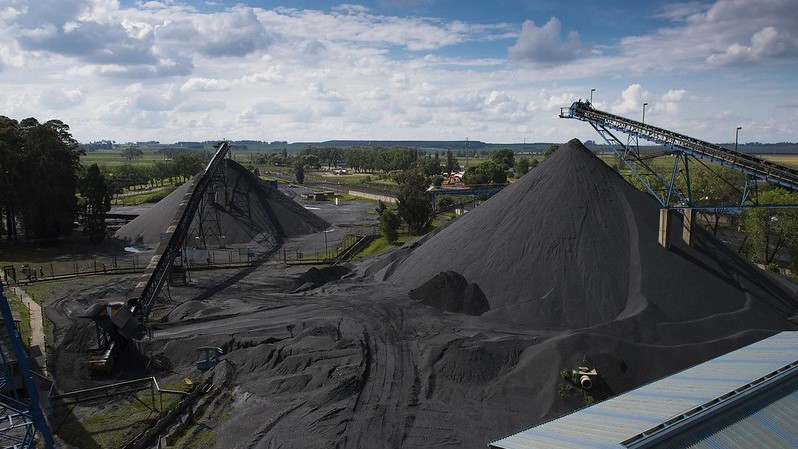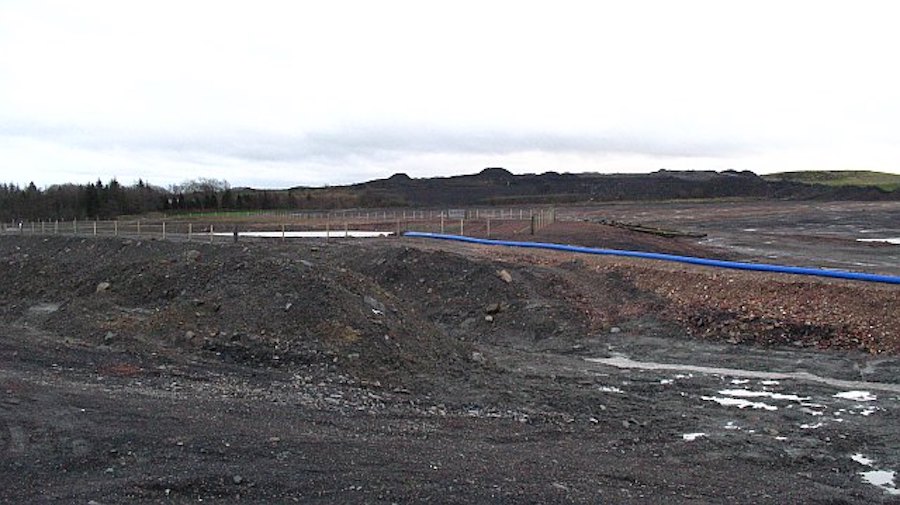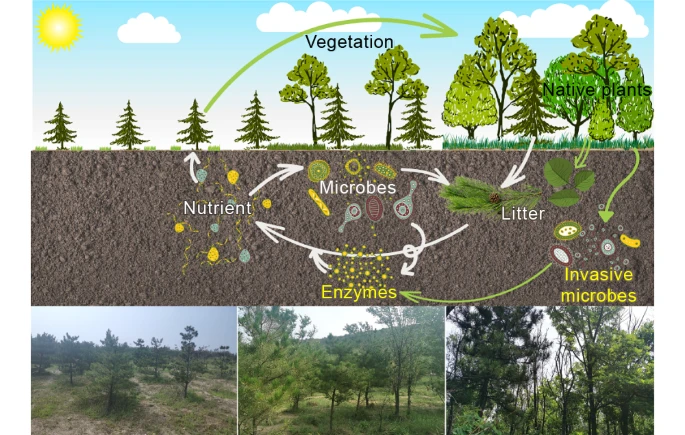Bloomberg News | September 6, 2022 |

Anglo American Thermal Coal Greenside Collieries.
Image from Anglo American via Flickr.
Thermal coal in Asia advanced to a record as a threat of supply disruptions adds new risks to a global energy sector already engulfed in crisis.

Spot physical coal loaded at Australia’s Newcastle port was priced at $436.71 a ton on Friday, an all-time high, according to a biweekly index compiled by OPIS seen by Bloomberg News. That’s nearly triple the price this time last year.
Newcastle futures for October jumped 5% to $463.75 a ton Monday, according to ICE Futures Europe, to the highest price in data stretching back to January 2016. Europe’s benchmark coal price is also trading at a record.
Uncertainty over gas flows to Europe and forecast stronger coal demand from the continent is continuing to propel prices of the fuel. There’s also a prospect of weather disruptions at mines in Australia, a key global supplier, with a third straight La Nina forecast for late 2022 likely to deliver heavier rainfall.
“Any severe disruptions to Australian coal shipments could push the high-calorific value price even to fresh highs,” Morgan Stanley analysts including Marius van Straaten said in a note.
Some previous La Nina periods have seen coal mines and railroads in Australia’s New South Wales and Queensland states disrupted by heavy rainfall, and output fell by an estimated 20% to 30% in a particularly severe weather event that spanned several months in 2010 and 2011.
Coal has seen a demand resurgence as a result of a squeeze on global gas supply as some buyers shun fuel imports from Russia, and with slow investments in other sources including renewables in many nations. Several European countries have resumed coal plants, while other key consumers including India have boosted imports.
(By Stephen Stapczynski and David Stringer)
Thermal coal in Asia advanced to a record as a threat of supply disruptions adds new risks to a global energy sector already engulfed in crisis.

Spot physical coal loaded at Australia’s Newcastle port was priced at $436.71 a ton on Friday, an all-time high, according to a biweekly index compiled by OPIS seen by Bloomberg News. That’s nearly triple the price this time last year.
Newcastle futures for October jumped 5% to $463.75 a ton Monday, according to ICE Futures Europe, to the highest price in data stretching back to January 2016. Europe’s benchmark coal price is also trading at a record.
Uncertainty over gas flows to Europe and forecast stronger coal demand from the continent is continuing to propel prices of the fuel. There’s also a prospect of weather disruptions at mines in Australia, a key global supplier, with a third straight La Nina forecast for late 2022 likely to deliver heavier rainfall.
“Any severe disruptions to Australian coal shipments could push the high-calorific value price even to fresh highs,” Morgan Stanley analysts including Marius van Straaten said in a note.
Some previous La Nina periods have seen coal mines and railroads in Australia’s New South Wales and Queensland states disrupted by heavy rainfall, and output fell by an estimated 20% to 30% in a particularly severe weather event that spanned several months in 2010 and 2011.
Coal has seen a demand resurgence as a result of a squeeze on global gas supply as some buyers shun fuel imports from Russia, and with slow investments in other sources including renewables in many nations. Several European countries have resumed coal plants, while other key consumers including India have boosted imports.
(By Stephen Stapczynski and David Stringer)
Compounds that promote vegetation diversity key to ecological restoration in open-pit coal mine dumps
Staff Writer | September 6, 2022

Open-pit coal mine.
Staff Writer | September 6, 2022

Open-pit coal mine.
(Reference image by Richard Webb, Wikimedia Commons).
A new study published in the journal Soil Ecology Letters demonstrates that soil urease and β-glucosidase are key supporters of the diversity of vegetation configuration which, in turn, is an important factor when it comes to the ecological restoration in open-pit coal mine dumps.

In detail, the two compounds promote the increase of vegetation diversity and biomass by boosting the accumulation of soil organic matter and nitrate nitrogen.
Lead researcher Fu Chen, from the China University of Mining and Technology, has conducted a series of studies on the restoration of damaged mine ecosystems in order to prove his hypothesis.
In one of the studies, Chen was able to demonstrate that the successional direction of the Pinus tabulaeformis plantations significantly shifted due to the invasion of surrounding plants, which resulted in an obvious increase in species number and vegetation coverage.
His team also found the original vegetation configuration, soil nutrient conditions and soil microbial communities were altered due to secondary succession.
“We chose to study the Antaibao open-pit coal mine located in the eastern Loess Plateau, where some artificial restoration projects began in 1992,” Chen said in a media statement.
“Plantations with the same vegetation configuration and artificial management measures had different restoration effects after 30 years of recovery time. Therefore, the Antaibao open-pit coal mine provides a proper and high-quality platform for the mechanism study of monoculture plantations on the secondary succession of mine ecosystem.”

A new study published in the journal Soil Ecology Letters demonstrates that soil urease and β-glucosidase are key supporters of the diversity of vegetation configuration which, in turn, is an important factor when it comes to the ecological restoration in open-pit coal mine dumps.

In detail, the two compounds promote the increase of vegetation diversity and biomass by boosting the accumulation of soil organic matter and nitrate nitrogen.
Lead researcher Fu Chen, from the China University of Mining and Technology, has conducted a series of studies on the restoration of damaged mine ecosystems in order to prove his hypothesis.
In one of the studies, Chen was able to demonstrate that the successional direction of the Pinus tabulaeformis plantations significantly shifted due to the invasion of surrounding plants, which resulted in an obvious increase in species number and vegetation coverage.
His team also found the original vegetation configuration, soil nutrient conditions and soil microbial communities were altered due to secondary succession.
“We chose to study the Antaibao open-pit coal mine located in the eastern Loess Plateau, where some artificial restoration projects began in 1992,” Chen said in a media statement.
“Plantations with the same vegetation configuration and artificial management measures had different restoration effects after 30 years of recovery time. Therefore, the Antaibao open-pit coal mine provides a proper and high-quality platform for the mechanism study of monoculture plantations on the secondary succession of mine ecosystem.”

Graphical abstract by Zhang et al. (From Soil Ecology Letters).
Following their analyses, Chen and his group noticed that the original vegetation configuration and soil nutrient conditions were altered due to secondary succession. With the advancement of the secondary succession process, the coverage of plants increased from 34.8% to 95.5%, soil organic matter increased from 9.30 g·kg-1 to 21.13 g·kg-1, and total nitrogen increased from 0.38 g·kg-1 to 1.01 g·kg-1. The activities of soil urease and β-glucosidase were increased by 1.7-fold and 53.26%, respectively.
Additionally, the secondary succession also changed the soil microbial community structure and function. The relative abundance of the Nitrospira genus which dominates the nitrification increased 5.2-fold. This result suggests that the invasion and diffusion of native plants and surrounding plants had a positive effect on ecological restoration, which is helpful to explore more reasonable selection and configuration of vegetation in the practice of mine ecological restoration.
“We also used the method of structural equation models and functional prediction to explore the role of microbes-mediated enzymes in the process of secondary succession and the interactions between plants, soil and microbes,” Chen said.
According to the scientist, the activities of several soil enzymes had a significantly positive impact on soil carbon, N, and P. And microbes played a positive role in facilitating plant and soil substance cycling on either scale. This result suggests the possibility of using industrial enzyme preparations such as urease and catalase to promote litter degradation, by improving soil fertility to accelerate the process of ecosystem cycle and succession.
“The study is an extension of our understanding of the ecological restoration in open-pit coal mine dump from plant configuration to microbial function, increasing our understanding of plant invasion and microbes-mediated enzymes in secondary succession of mine dumps on Loess Plateau,” Chen pointed out.
Following their analyses, Chen and his group noticed that the original vegetation configuration and soil nutrient conditions were altered due to secondary succession. With the advancement of the secondary succession process, the coverage of plants increased from 34.8% to 95.5%, soil organic matter increased from 9.30 g·kg-1 to 21.13 g·kg-1, and total nitrogen increased from 0.38 g·kg-1 to 1.01 g·kg-1. The activities of soil urease and β-glucosidase were increased by 1.7-fold and 53.26%, respectively.
Additionally, the secondary succession also changed the soil microbial community structure and function. The relative abundance of the Nitrospira genus which dominates the nitrification increased 5.2-fold. This result suggests that the invasion and diffusion of native plants and surrounding plants had a positive effect on ecological restoration, which is helpful to explore more reasonable selection and configuration of vegetation in the practice of mine ecological restoration.
“We also used the method of structural equation models and functional prediction to explore the role of microbes-mediated enzymes in the process of secondary succession and the interactions between plants, soil and microbes,” Chen said.
According to the scientist, the activities of several soil enzymes had a significantly positive impact on soil carbon, N, and P. And microbes played a positive role in facilitating plant and soil substance cycling on either scale. This result suggests the possibility of using industrial enzyme preparations such as urease and catalase to promote litter degradation, by improving soil fertility to accelerate the process of ecosystem cycle and succession.
“The study is an extension of our understanding of the ecological restoration in open-pit coal mine dump from plant configuration to microbial function, increasing our understanding of plant invasion and microbes-mediated enzymes in secondary succession of mine dumps on Loess Plateau,” Chen pointed out.
No comments:
Post a Comment